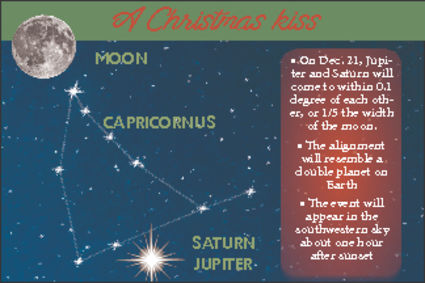'Great conjunction' offers rare planetary event
December 17, 2020
On Dec. 21 - the shortest day of the year - two planets will align in the evening sky, giving stargazers an opportunity to view a Christmas kiss.
The last time the Jupiter and Saturn passed this close to each other was on July 16, 1623. Prior to that, they crossed paths in 1226.
The proximity of planets may make the two appear as one unit during the winter solstice.
The Christmas kiss, dubbed by Dr. Brad Tucker of Australia's National University, will be visible approximately one hour following sunset in the western sky.
Mark Urwiler, owner of Honey Creek Observatory, located north of O'Neill, said Jupiter and Saturn have been visible, as twilight nears, for the past two weeks.
"It looks like they are touching," he said.
Monday evening, the two planets will be one-tenth of a degree apart, according to Urwiler.
That's one-fifth the width of Earth's moon.
With binoculars, Jupiter's four brightest moons will be visible.
"You won't see Saturn's rings unless you're using a 15-power scope," he said.
"To the unaided eye, the conjunciton will look like a single bright star," Urwiler said. "It'll be pretty unmistakable if you're looking to the west."
The former science instructor said Jupiter and Mars align approximately every 21 years, but they are not this close.
"That's what so special about this," he said.
Urwiler said he has not heard the term, "Christmas kiss," used to describe the upcoming alignment.
The Christmas star may be reliant on the calendar, for its meaning.
"The calendar has been revised three or four times," he said.
The Gregorian calendar, first introduced by Pope Gregory XIII in 1582, modified the Julian calendar and reduced the average year from 365.25 days to 365.2425 days, adding a leap year to make the average.
"The modern Gerogian calendar has been updated several times since the birth and death of Christ," Urwiler said.
One theory explains the Star of Bethlehem as a conjunction of Jupiter, Saturn and Venus.
"The planets were so close, it looked like one giant star," Urwiler said.
Venus, when closest to earth, shines brighter than the other two.
Currently, it appears in the morning and can be viewed in the southeastern sky.
"We have two of them together now. If all three were together, we'd have something bright," he said.




Reader Comments(0)